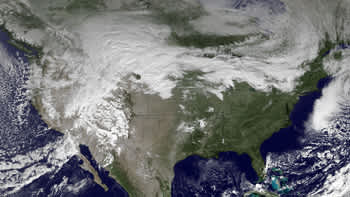Prepping for Winter Weather Emergencies
Laurie Lee Dovey 11.13.12

Superstorm Sandy is a unequivocal reminder that weather can turn lives upside down. The winter months are no exception. And with a confusing El Niño weather pattern, predicting the weather for this winter is more difficult than usual.
Forecasters with the National Oceanic and Atmospheric Administration’s Climate Prediction Center say a wavering El Niño, expected to have developed by now (late Oct. 2012), makes this year’s winter outlook less certain than previous years.
“This is one of the most challenging outlooks we’ve produced in recent years because El Niño decided not to show up as expected,” said Mike Halpert, deputy director of NOAA’s Climate Prediction Center. “In fact, it stalled out last month, leaving neutral conditions in place in the tropical Pacific.”
Ross McRoy, president of Enviro-Log, Inc., a leader in eco-friendly products for home heating, and outdoor activities such as camping, hiking and tailgating, urges households to prepare for extreme weather by following important safety tips that can help protect family members.
“Every household should prepare for extreme weather in advance and be ready for loss of power and utilities or worse,” McRoy said. “We encourage every household to have an emergency plan and emergency kits stored in homes and vehicles that are ready for use regardless of season. In situations of flooding or downed power lines, it is important to evacuate the premises and seek shelter elsewhere.”
McRoy stresses some key essentials to make difficult situations more manageable.
Make a family emergency plan. Everyone should know what to do during in an emergency in case all family members are not together. Pick a place to meet and make sure everyone knows the address of the location. The Federal Emergency Management Agency (FEMA) recommends that you program a family member as “ICE” (In Case of Emergency) in your phone. If you are in an accident and not able to communicate, emergency personnel will often check your ICE listings in order to get a hold of someone you know.

Have an emergency kit in your house.
- One gallon of water per person per day for at least 10 days, for drinking and sanitation in case of emergencies
- A 10 day supply of non-perishable food and a manual can opener
- A battery-powered or hand-crank NOAA Weather Radio with tone alert, and extra batteries
- A flashlight and extra batteries
- A lighter, flint or waterproof matches for starting fires
- Candles
- Firelogs* or firewood to be used for home heating and cooking (*only brands approved for cooking)
- A first-aid kit
- Moist towelettes, garbage bags and plastic ties for personal sanitation
- A laminated area map and compass
- A cell phone with an extra battery or solar charger
- A LAN-line phone that operates without electrical power
- Any special-needs items for children, seniors or people with disabilities
- Water and supplies for pets
- Supply of critical medicines and prescriptions
Carry a survival kit in your vehicle.
- A first-aid kit
- Blankets or sleeping bags
- A cellular phone or two-way radio
- A windshield scraper with snow brush
- Flashlight with batteries
- Extra winter clothes including shoes, hats and gloves
- Compact shovel
- Traction aids (bag of sand or cat litter) and tow chain
- Emergency flares
- Jumper cables
- Non-perishable food and bottled water
- A laminated road map
- A transportable non-restrictive heat source such as firelogs (firewood cannot be transported by law in some locations)
- Do not store liquid fuels in your car
- Any special-needs items for children, seniors or people with disabilities, who might be travelling with you
- Water and supplies for any pets travelling with you
McRoy also encourages families to use extra caution and follow proper safety guidelines when operating portable generators. McRoy recommends following Occupational Safety and Health Administration (OSHA) guidelines on proper generator use.
For additional information on preparing for extreme winter weather, please visit:
- Centers for Disease Control and Prevention (CDC) – www.bt.cdc.gov/disasters/winter/guide.asp
- Federal Emergency Management Association (FEMA) — www.ready.gov/winter-weather
- Red Cross – www.redcross.org/

